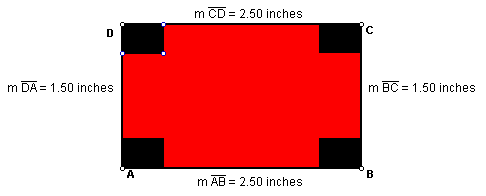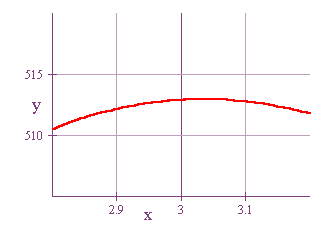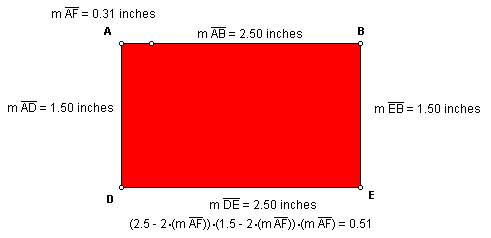Final
Part One
Rectangular Box Problem
EMT 668
By Kelly Pierce
Consider a rectangular sheet of cardboard 15 inches by 25 inches. If a small
square is cut from each corner and each side folded up along the cuts to
form a lidless box. I am using an automatic drawer (GSP) to draw a box and
demonstrate the problem.

The area in red is the area of the cardboard after the squares have been
removed from the sheet. If we were to write an equation for the volume,
we would get the following: Volume = (15-2x) * (25-2x)*(x),
where x is the side of the squares removed.
Now, let's graph the volume with relation to the variable x.

After analyzing the graph, students should be able to tell
that the maximum volume occurs around 510 and the x value is about 3. Let's
zoom into the graph and clarify where the maximum occurs.

After zooming in on the maximum point, we can see the maximum occurs
at volume = 513 inches3 and the size of square is about 3.2 inches.
To find maximum points of an equation, a student needs to take the derivative.
The derivative of the Volume equation is
y' = 12x^2 - 160x +375
After taking the derivative, set the equation equal to zero and
solve. The solutions are 10.3 and 3.03. However, 10.3 is not a reasonable
answer because it lies outside the range. Analyze the original graph, for
what values of x is the volume equal to 400? The value of x is about 1.5.
We will approach this problem using a spreadsheet application. First,
let's set up the spreadsheet. Column A will be the variable x, which is
the length of the square you are cutting out of the sheet. Column B calculates
the longest side of the box and column C is the shortest length of the box.
Finally, column D calculates the Volume of the box. Notice, after x = 7
the volume is negative. This shows the limit of the shortest side of the
cardboard. Look at the values for volume. The maximum volume occurs at 3.
Square |
Length |
Width |
Volume |
(x) |
(25 - 2x) |
(15-2x) |
|
1 |
23 |
13 |
299 |
2 |
21 |
11 |
462 |
3 |
19 |
9 |
513 |
4 |
17 |
7 |
476 |
5 |
15 |
5 |
375 |
6 |
13 |
3 |
234 |
7 |
11 |
1 |
77 |
8 |
9 |
-1 |
-72 |
|
|
|
|
|
Let's now look closer at the values around 3.
Square |
Length |
Width |
Volume |
(x) |
(25 - 2x) |
(15-2x) |
|
3.00 |
19.00 |
9.00 |
513.00 |
3.01 |
18.98 |
8.98 |
513.03 |
3.02 |
18.96 |
8.96 |
513.04 |
3.03 |
18.94 |
8.94 |
513.05 |
3.04 |
18.92 |
8.92 |
513.05 |
3.05 |
18.90 |
8.90 |
513.04 |
3.06 |
18.88 |
8.88 |
513.02 |
3.07 |
18.86 |
8.86 |
513.00 |
The data agrees with the graph above. The maximum value occurs at x =
3.03 or 3.04.
We can also use the graph at the beginning of this exploration to
find the value of x when the volume is 400 cubic inches. The x value is
about 1.5. Let's use Excel to show where the solution occurs.
Square |
Length |
Width |
Volume |
(x) |
(25 - 2x) |
(15-2x) |
|
1.50 |
22.00 |
12.00 |
396.00 |
1.51 |
21.98 |
11.98 |
397.61 |
1.52 |
21.96 |
11.96 |
399.22 |
1.53 |
21.94 |
11.94 |
400.80 |
1.54 |
21.92 |
11.92 |
402.38 |
1.55 |
21.90 |
11.90 |
403.95 |
1.56 |
21.88 |
11.88 |
405.50 |
1.57 |
21.86 |
11.86 |
407.04 |
The spreadsheet shows that the solution occurs between 1.52 and 1.53.
Let's continue using the spreadsheets to find the solutions by changing
the x coordinates to 5 or 6 decimals.
1.524926 |
21.950148 |
11.950148 |
399.999553 |
1.524927 |
21.950146 |
11.950146 |
399.999712 |
1.524928 |
21.950144 |
11.950144 |
399.999871 |
1.524929 |
21.950142 |
11.950142 |
400.000030 |
1.524930 |
21.950140 |
11.950140 |
400.000189 |
1.524931 |
21.950138 |
11.950138 |
400.000348 |
1.524932 |
21.950136 |
11.950136 |
400.000507 |
1.524933 |
21.950134 |
11.950134 |
400.000665 |
1.524934 |
21.950132 |
11.950132 |
400.000824 |
1.524935 |
21.950130 |
11.950130 |
400.000983 |
The closest value to 6 digits is 1.524929. Excel is able to give you a more
exact answer than a graph.
You can use GSP to solve this problem, but it is more difficult. First,
construct the polygon and measure all the sides. Next, construct a segment
you will vary to determine the length. Below, line segment AF is the segment
that represents the square we will cut out. Then, derive a formula to calculate
the volume of the lidless box. Vary the length of AF to determine the maximum
volume. I used 2.5 and 1.5 inches instead of 25 and 15 to save space.

Another approach is actually animate the box to give the full 3-D effect.
First, I constructed a sheet using GSP that has the dimensions 2.10 by 1.25.
Below, you will find a copy of the sheet.

Now, I would like to constuct the box that coincides with the sheet above.
Below, you will find not only the box but the dimensions of the box.

The next logical step to this problem is to use the animation feature
of GSP to animate the different values of x and calculate the volume of
the box. If you animate the box slowly, it will be apparent which value
of x that the maximum volume occurs.

Click Here to see the animation.
The maximum volume (.30 inches cubed) of the box occurs when the segment
EF is .28 inches.
I hope this exploration shows you several different tools you can use to
solve the same problem. Which one are you more comfortable using? Or do
you have any other suggestions we could do?
View other Final Documents
Return to Kelly Pierce's Home Page
Email Kelly Pierce






